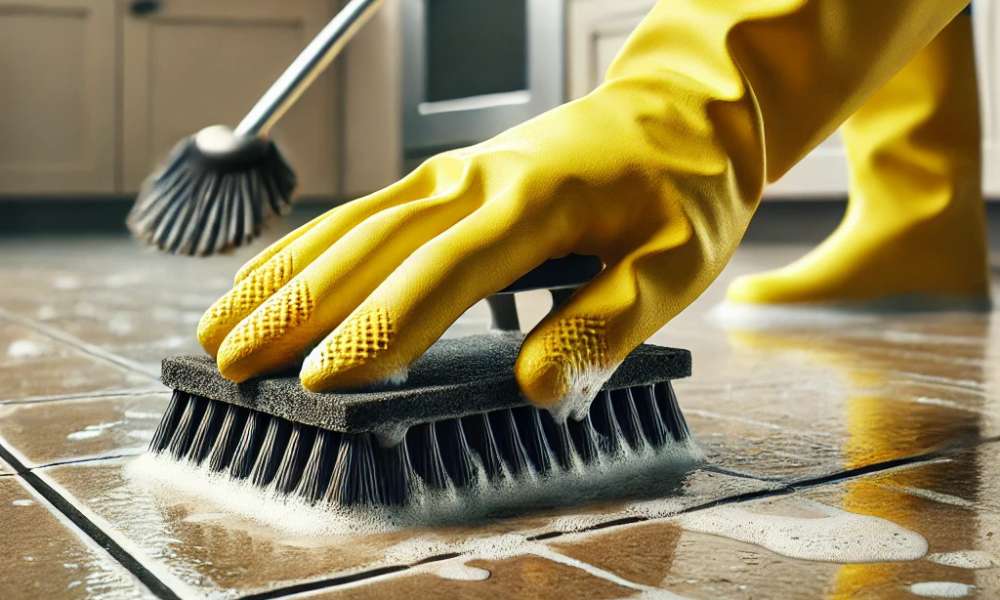Greasy kitchen floor tiles can turn your cooking space into a slippery hazard, making cleaning a top priority. Whether it’s oil splatters from frying or built-up grime from daily cooking, tackling the mess can feel overwhelming. But don’t worry! In this guide, we’ll show you how to clean greasy kitchen floor tiles quickly and effectively using simple household ingredients and expert techniques. Say goodbye to stubborn grease and hello to sparkling, slip-free floors! Let’s dive in and make your kitchen shine.
1. Understanding Grease Buildup on Kitchen Tiles
Grease does not accumulate overnight; it forms gradually as microscopic oil particles settle on surfaces. This is especially common in kitchens with frequent frying and grilling. Tiles with textured surfaces or porous materials, such as unglazed ceramic or natural stone, tend to trap grease more easily than glossy tiles. Over time, this buildup not only dulls the tiles but also fosters bacterial growth, making the kitchen environment less sanitary. Recognizing the early signs of grease accumulation—such as a slightly sticky feel or dull patches—can help address the issue before it worsens.
2. Essential Supplies
To effectively remove grease, having the right cleaning supplies is crucial. Natural solutions like white vinegar, baking soda, and lemon juice act as gentle yet powerful degreasers. For tougher stains, commercial degreasers formulated for tiled surfaces provide a stronger solution. Tools such as microfiber mops, scrub brushes, and steam cleaners aid in the process by dislodging grease without damaging the tiles. A sponge or soft cloth is useful for spot cleaning, ensuring that no residue is left behind.
3. Pre-Cleaning Steps for Better Results
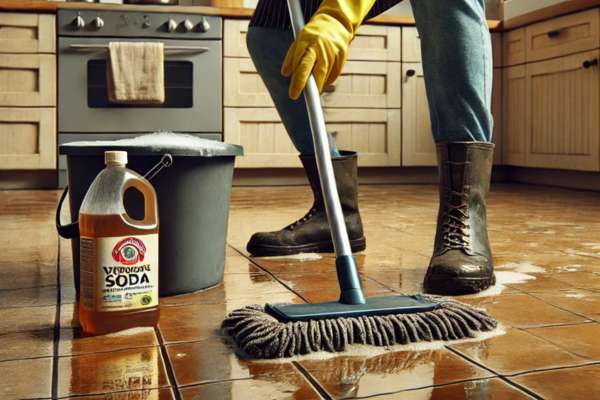
Before deep cleaning greasy tiles, it’s essential to remove loose dirt and debris. Sweeping with a soft-bristle broom or vacuuming helps prevent dust from turning into a muddy residue when wet. For heavy grease spots, pre-treating the area with a degreasing solution or dish soap can help loosen the buildup, making it easier to remove during the cleaning process. Allowing the cleaning solution to sit for a few minutes before scrubbing enhances its effectiveness.
4. Best Methods for Cleaning
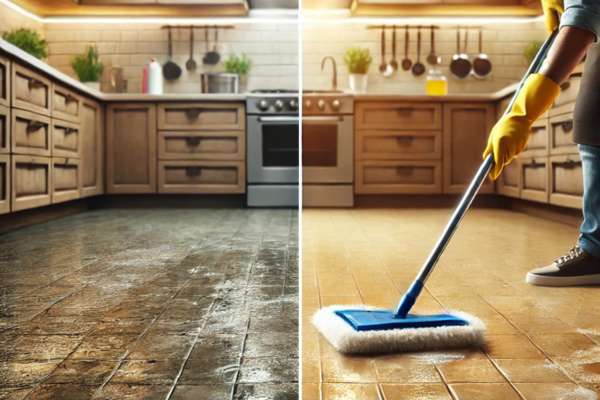
Different methods can be employed depending on the severity of the grease:
- Dish Soap and Hot Water: A basic but effective method that breaks down grease while being gentle on tiles.
- Vinegar and Baking Soda Solution: The acidic nature of vinegar dissolves grease, while baking soda adds abrasion for better cleaning.
- Lemon Juice and Salt: Ideal for natural stone tiles, this mixture not only removes grease but also adds a fresh scent.
- Hydrogen Peroxide and Baking Soda Paste: Great for deep cleaning and stain removal, particularly in grout lines.
- Commercial Degreasers: Stronger formulations should be used when natural solutions are not sufficient, but they should be applied carefully to avoid tile discoloration.
5. Scrubbing Techniques for Stubborn Grease Stains
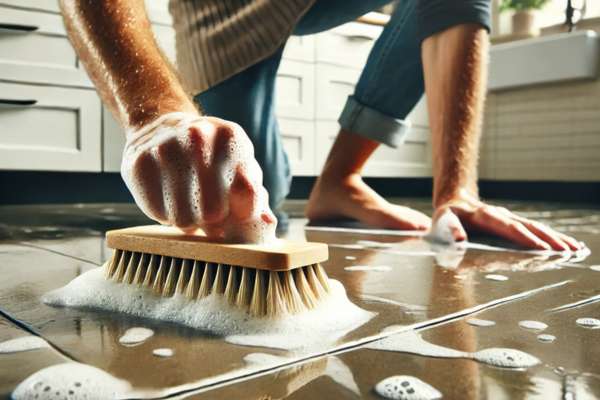
When dealing with stubborn grease patches, the right scrubbing technique is essential. A circular motion is often more effective than a back-and-forth scrubbing pattern, as it lifts oily without spreading it. Using a soft-bristle brush or a microfiber mop minimizes the risk of scratching tiles. Steam cleaning is another excellent option, as the high-temperature steam breaks down grease molecules, making them easier to wipe away.
6. Cleaning Grout Between Greasy Floor Tiles
Grease tends to settle into grout lines, darkening them and making them harder to clean. A paste of baking soda and hydrogen peroxide works wonders in lifting deep-set stains. A stiff-bristle toothbrush or grout brush can be used to scrub the mixture into the grout lines for optimal results. Sealing grout lines after cleaning helps prevent future grease absorption, keeping the tiles looking fresh longer.
7. Rinsing and Drying the Floor Properly
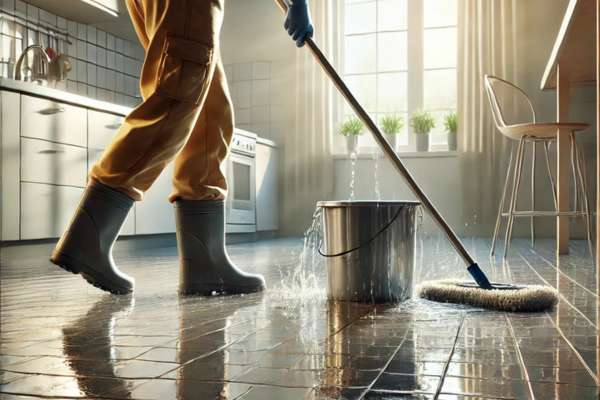
After cleaning, thoroughly rinsing the tiles with warm water removes any remaining cleaning residue. Leaving soap or degreasing agents on the tiles can lead to a sticky surface that attracts more grease. Drying the floor with a microfiber cloth or air-drying prevents water spots and ensures a streak-free finish. Avoid excessive water use on porous tiles to prevent water damage.
8. Preventing Grease Buildup on Kitchen Floor Tiles
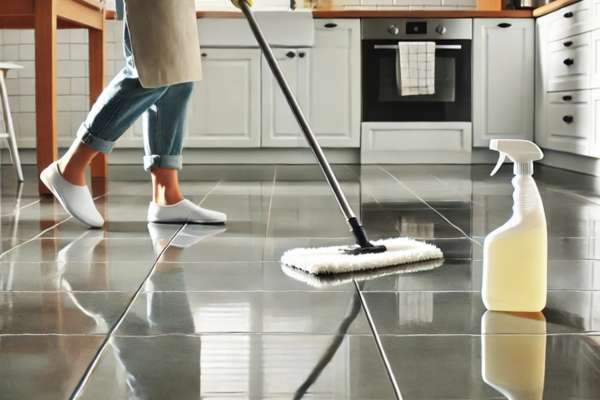
Preventing grease accumulation is more manageable than constantly deep cleaning. Regular sweeping and mopping with a mild detergent help maintain cleanliness. Placing absorbent mats or rugs in high-traffic areas, such as near the stove and sink, reduces direct contact between grease and tiles. Immediately wiping up spills prevents oil from settling, reducing the effort required during cleaning.
9. Eco-Friendly Alternatives
For those who prefer environmentally friendly cleaning solutions, several alternatives work effectively. A mix of warm water, vinegar, and a few drops of essential oils provides a natural degreasing spray. Castile soap, derived from plant oils, is another excellent option that cuts through grease without harsh chemicals. Steam mops eliminate oily using only water, making them a sustainable choice. Read, clean kitchen floor
10. Common Mistakes to Avoid
Several mistakes can make cleaning more challenging or even damage tiles. Using excessive water on porous tiles can lead to water absorption and potential mold growth. Mixing incompatible cleaning agents, such as vinegar and bleach, can create harmful fumes. Over-scrubbing textured tiles with abrasive brushes may wear down their protective coating. Using too much detergent without thorough rinsing results in sticky residue, attracting even more grease.
11. Best Practices for Long-Term Kitchen Floor Tile Maintenance
To maintain grease-free tiles in the long run, a structured cleaning schedule is essential. Daily sweeping and light mopping keep surface dirt at bay. A weekly deep clean with a gentle degreasing solution prevents the buildup of stubborn oily. Applying a sealant to porous tiles provides an additional layer of protection against oil penetration. For severe grease accumulation, periodic professional tile cleaning ensures a thorough refresh.
Conclusion
Grease-covered kitchen floor tiles can be both unsightly and hazardous, but with the right approach, they can be restored to their original shine. Implementing effective cleaning techniques, using proper tools and solutions, and adopting preventive measures ensure that oily buildup remains minimal. By incorporating regular maintenance into your cleaning routine, you can enjoy a spotless, oily-free kitchen floor with ease.
